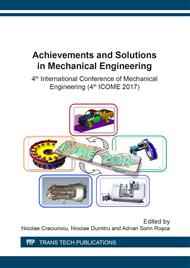[1]
R. Holkar, Y. N. Sule-Patil, S. M. Pise, Y. A. Godase, V. S. Jagadale, Numerical Simulation of Steady Flow through Engine Intake System Using CFD, IOSR Journal of Mechanical and Civil Engineering (IOSR-JMCE) e-ISSN: 2278-1684, p-ISSN: 2320-334X, Volume 12, Issue 1 Ver. II (Jan- Feb. 2015), PP 30-45.
DOI: 10.9790/1684
Google Scholar
[2]
J. Bayas, A. Wankar, N.P. Jadhav, A review paper on effect of intake manifold geometry on performance of IC engine, IJARIIE-ISSN (O)-2395-4396, Vol-2 Issue-2 (2016).
Google Scholar
[3]
3. D. Deshmukh, , R. Kumar, M. Garg, M. J. Nayeem, and V. Lakshminarasimhan, , Optimisation of Gas Exchange Process on a Single Cylinder Small 4-Stroke Engine by Intake and Exhaust Tuning: Experimentation and Simulation, SAE Paper 2004-32-0007.
DOI: 10.4271/2004-32-0007
Google Scholar
[4]
J. Taylor, D. Gurney and P. Freeland et. al. Intake Manifold Length Effects on Turbocharged Gasoline Downsizing Engine Performance and Fuel Economy, SAE Paper, 2012-01-0714. ).
DOI: 10.4271/2012-01-0714
Google Scholar
[5]
J. Lee, K. Yoon, A Numerical and Experimental Study on the Optimal Design for the Intake System of the MPI Spark Ignition Engines‖ , KSME Journal, Vol 10, No. 4 pp.471-479, (1996). 1).
DOI: 10.1007/bf02942783
Google Scholar
[6]
P. Benny, P. Ganesan, Flow Field Development In a Direct Injection Diesel Engine With Different Manifolds‖, IJEST: Vol. 2, No. 1, pp.80-91, (2010).
Google Scholar
[7]
M. Safari, M. Ghamari and A. Nasiritosi, Intake manifold optimization by using 3-D CFD analysis, SAE paper no. 2003-32-0073. page no. 1-5.
DOI: 10.4271/2003-32-0073
Google Scholar
[8]
J. Benajes, E. Reyes, V. Bermudez and J. R. Serrano, Predesign Criteria for Exhaust Manifolds in I.C. Automotive Engines, SAE paper no. 980783. page no. 1-7.
DOI: 10.4271/980783
Google Scholar
[9]
S. Karthikeyan, R. Hariganesh, M. Sathyanadan, S. Krishnan, Computational Analysis Of Intake Manifold Design And Experimental Investigation On Diesel Engine For LCV, International Journal Of Engineering Science And Technology (IJEST), ISSN : 0975-5462, Vol. 3 No. 4 Mar 2011, Pp 2359-2367.
Google Scholar
[10]
A. Martínez-Sanz, S. Sánchez-Caballero, A. Viu and R. Pla-Ferrando, Design And Optimization Of Intake Manifold In A Volkswagen Car, ANNALS of the ORADEA UNIVERSITY. Fascicle of Management and Technological Engineering, Vol X (XX) , (2011).
DOI: 10.15660/auofmte.2011-2.2338
Google Scholar
[11]
https: /cfdninja. com/wp-content/uploads/2016/05/CFD-Process.
Google Scholar


